Building a Growth Strategy
Lessons and templates from taking Patreon to $1B in annual GMV
Hi there, it’s Adam. 🤗 Welcome to my weekly newsletter. I started this newsletter to provide a no-bullshit, guided approach to solving some of the hardest problems for people and companies. That includes Growth, Product, company building and parenting while working. Subscribe and never miss an issue. I’ve got a podcast on fatherhood and startups - check out Startup Dad here. Questions? Ask them here.
It was the first half of 2019 and Patreon, having just come off a massive price restructuring and a 2017 rebrand, had an eye to the future. We were planning for the next 18 months or so and individual organizations were tasked with developing these plans.
As VP of Product for Growth—which at the time included Creator Acquisition (including Growth Marketing), Creator Activation, Creator Revenue and (recommended) Monetization—it was my job to articulate our Growth Strategy. Later, with the help of Adrienne Wong, I would also go on to oversee our Internationalization efforts; a separate strategy from this one.
I first wrote about this process in a Reforge Artifact that lives here. But it was so popular that I decided to expand on it and bring it to my newsletter audience.
Patreon had reached a point where we were starting to think about going public which meant a few changes:
We were getting much more rigorous about the future and the size, horizon and return of investments we made (see also: Evaluating Product Investments).
We were benchmarking against other companies who had gone from our size (Series D, ~$75-100M in ARR) to IPO.
We were getting much more mature as a company in general with more teams, more stakeholders, and waaaaaay more creators (and patrons).
I believed, and still do, that there was an enormous opportunity for the Growth team(s) at Patreon. The team there must still think so as well because 25% of their open roles are currently on Growth.
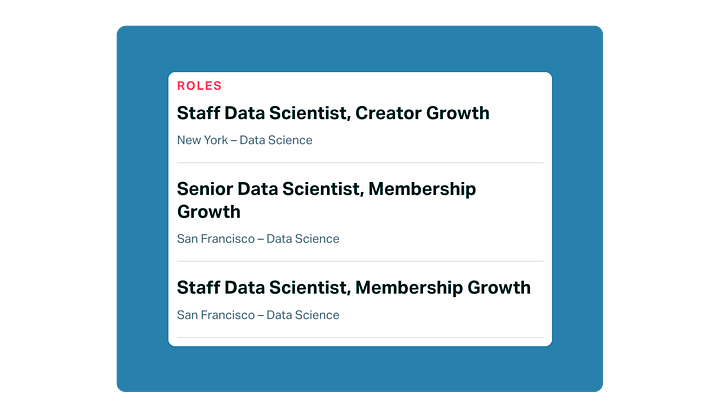

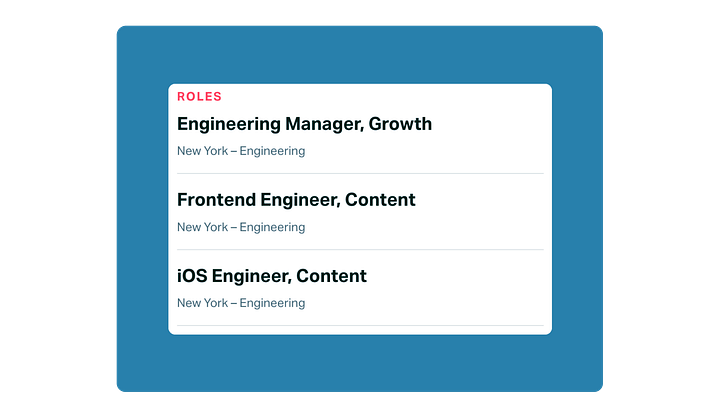

That enormous opportunity wouldn’t be realized without more investment and that investment wouldn’t be approved without a comprehensive view of the vision and strategy for the teams.
My goals with this exercise and the resulting presentation were:
Clearly define the mission of the Growth organization. We had worked on a lot of different projects over the last year because of the company-wide focus on pricing changes so it was time to re-establish ourselves.
Tell a compelling story around the vision for the team; one that got people excited about the possibilities.
Communicate that story from the perspective of a customer.
Frame it in a way emphasized the metrics the company cared about.
Provide a rigorous ROI analysis that supported the vision and garnered the support of our Finance team.
With any presentation you want to cater it to your audience. The audience for this was our executive leadership team (CEO, SVPs of Product & Engineering, VP Finance, VP Ops, and CRO) alongside key stakeholders in leadership across those same functions.
The presentation is divided into the following sections—I’ll go through each one and explain it:
Mission
Strategy
Team topology to deliver strategy mapped to Creator lifecycle
Value of each team
Vision from the perspective of a Creator across the lifecycle
Execution and resourcing by team
Mission and strategy of each team
Forecasted impact by team
Summary and takeaways
At the end I’ve included a downloadable link to the entire file if you’d like to make your own version.
Mission
I was about to ask for a very sizable, but needed, investment in the Growth organization and felt it was important to provide a clear mission statement for the company. As I mentioned above, the Growth organization had worked on a lot of different streams of work since I had joined: classic “Growth” work, our rebrand, establishing our app platform, a merchandise pilot (leading to the acquisition of Kit), building a “lite” product for our pricing and packaging initiative, and the launch of that pricing and packaging.
I wanted to ground people in what our focus and ownership would be going forward: helping bring more valuable creators on to the Patreon platform and make sure they realized their full potential. This mission was fully aligned with both the Creator (our core customer) and the business. One of the beautiful things about Patreon is that when Creators make more money so does Patreon!
Strategy
Normally you’d follow the “Mission -> Vision -> Strategy” waterfall, but I expected to spend a lot of time on vision later in the presentation and wanted to establish the “how” right away. We also had a very bottom-line culture at Patreon so it was best practice to never bury the lede.
Our strategy is to guide you through every step of your creative journey—from your first consideration of membership through the long-term success of your business.
So that you can build a membership that lasts.
The key parts here were “every step” of the creative journey and building a membership “that lasts.” Creators had very different needs as they progressed through their journey on the platform and I wanted it to be clear that there were several sub-teams within Growth that needed to do their part to help a Creator grow.
Team Topology
The purpose of this part of the presentation was to provide a quick overview of how we were going to deliver on the strategy, and start to preview some of my asks around team investment.
At the top is the Creator journey - Find, Convince, Build, etc. I wanted to show how the teams would align to the different parts of the journey.
I was introducing and repackaging several of our core Growth teams:
The find and convince stages would be our logged-out Website team coupled with an investment in Growth and Performance Marketing. We’d call that group Creator Acquisition. Their role is to generate qualified leads and creator signups.
The current Creator Acquisition team, focused on the onboarding and launch experience, would be rebranded to Creator Activation. Their role is to ensure that creators build powerful, engaging memberships and launch them with great excitement. They’d take the qualified leads and creator signups and help propel them to success.
Creator Revenue comes in post-launch to help creators continue to grow through the various expansion levers of pledge value acquisition. This is a Creator’s ability to acquire and expand the value of the patrons paying them.
Finally, driving the blended Membership Solutions margin and maximizing Gross Profit would be an investment in Monetization. We had just launched a new pricing and packaging strategy and it was important that creators ended up in the right package long-term as well as having new and expanded ways to monetize.
The second part of this team topology was the impact preview of each of the teams. This was a second slide and separated from the first because I didn’t want to distract the focus from understanding what the teams were focused on with a discussion around impact numbers (at least not yet).
Your leadership team will care about the impact to the company P&L (remember: Evaluating Product Investments) so it’s important to frame your investments with impact. We used TMV, which was our version of the more traditional GMV (gross merchandise value) of a marketplace, and stood for Total Membership Value.
With a baseline understanding of mission, strategy, teams and impact it was time to get the room excited about the future and give them examples of what we could achieve.
Note: This is a pretty long newsletter post. It’ll be easier to read in the App or on the Web since your email client will probably swallow the second half. You can read it on Web here.
Growth Team Vision
I needed to tell a compelling story about what it meant to be a successful creator on Patreon. The goal was to get the room excited about what we could be building before I ended with what it would take to get there (investment, people, etc.) I believe that visions should be visual so that means video, imagery, mockups, or storyboards can all be used to illustrate your vision. It should be accompanied by a supporting narrative that steps people through the story and matches the visuals.
Here are some of the highlights of the vision:
Customer Quotes
We wanted to support each step of the vision with some grounding in feedback from customers. We did that through selective showcasing of customer quotes from a repository of qualitative interviews.
It was also important to remind everyone what we had discovered as part of our company strategy creation—the size and scale of the creator economy and our role in bringing more of those creators to the platform.
At the time, the percentages represented what percentage of the addressable market we believe we had reached. You can see that we had a very high ceiling. Given that this TAM is from 2019 it is significantly larger today since the creator population was expanding in each of these creator types. One of the reasons I remain very bullish on Patreon!
Find Stage
A creator’s first exposure to Patreon was typically through another creator that they respected. So the “landing page” for Patreon was the creator page. Prospective creators would research dozens of other creator pages to inform their own strategy.
Creators also had a lot of questions from “what is membership” to “how much can I make?” We knew that we needed to surface a way for creators to answer these important questions. Earnings projections were even more important now that we had given all creators the ability to hide their earnings number on their page (more on that in a future newsletter).
As mentioned above the dominant way that we grew was word-of-mouth from one creator to another (either via casual discovery or direct recommendation). We knew we needed more channels over the long-term to productize lead generation like content.
Convince Stage
We knew creators struggled with how they should get started. The research across dozens of other creator pages was cumbersome and since we didn’t have an easy discovery mechanism it was sometimes impossible. We wanted creators to know that setting up your page could be fairly turnkey and the way to do that was to leverage Membership Templates.
In addition, one way that a creator could build their own confidence in launching on Patreon, and essentially convince themselves, was via polling their fans ahead of time. We wanted creators to be able to ask about various tiers of membership and show previews right on their fan engagement channels (i.e. most of the major social networks).
Build Stage
Once you were convinced we wanted to make it easy to select your pricing plan and get started building your membership. Our vision for this was to leverage template selection as the recommendation catalyst for which of our new pricing tiers you should sign up for.
We also knew that, like a lot of products, the number of up-front decisions and “blank canvas” problem really plagued creators. Many would drop off because of the amount of effort we asked for in the onboarding experience. To make this easier we would offer guidance and quick starts using templates and the concept of “structured benefits” to reduce the amount of work for a creator to offer and deliver value to their patrons.
A note on structured benefits: I still believe that the intersection of patron behavior and turnkey benefit delivery is one of the greatest unlocks of scaling the membership model and Patreon still has a lot of opportunity here.
Launch Stage
When a creator has climbed up and over the decision hill of building their membership the next most significant friction point was in the announcement and ongoing promotion of their membership offering.
This was important for a few reasons:
Creators generally didn’t like promoting their Patreon page; they liked creating. So a key opportunity was to tie the page to the content.
Despite getting early, positive signals in the “convince” stage creators were still nervous about that launch event and the reception from their fans.
Launching would introduce a new workstream into an already busy day. We wanted to make this as straightforward and guided as possible.
Momentum matters. A creator was most excited at launch as the patrons started rolling in and we wanted to help them capitalize on that enthusiasm.
A creator’s initial earnings within the first few months were a very accurate predictor of their lifetime value on the platform. The more successful they were, the more successful Patreon would be.
Grow Stage
Once a creator had launched and acquired their initial patrons they needed a way to continue enticing their fans to join. They didn’t want to continue ringing the Patreon bell like the town crier and saying “Join my Patreon!” so we wanted to give them tools to create ongoing excitement and incentive. These were everything from discounts for annual patronage to turnkey special offers to entice new patrons and upgrade existing subscriptions.
We also wanted to reduce friction for new patrons by better representing a creator’s offering and allowing creators to highlight tiers and posts.
Note: The $1 tier was one of the hardest habits to break but through a series of educational callouts and some “opinionated defaults” we were able to reduce the number of creators with a $1 tier substantially over the course of my tenure.
Scale Stage
The last phase of a creator’s journey is the Scale Stage. When creators reached a certain size they needed a significant amount of automation and turnkey marketing support. Think about what a large-scale SaaS business might need when they’re 10, 20, or even 30 thousand customers. Now imagine a solo creator with 40,000+ patrons.
We envisioned features like automated merchandise creation and delivery, price discounting and free-trial capabilities for creators along with coupling offline events and capturing new patrons IRL.
After twenty vision slides and a roomful of people hanging on the edge of their seat (this is my recollection, of course) it was time to reconnect this with the preview and make the ask.
Execution and resourcing by team
I wanted the room to know that there was a cost to delivering on this vision and strategy—we needed to invest in teams, hire new people, and focus on the long-term returns of each group.
In making the case for investment, I wanted it to be clear what each team would own from the vision I had just taken us through. I created the summary above as well as a breakdown of the mission and strategy for each individual team.
For each team I then showed the investment case and forecasted impact. I’ve redacted the exact amounts from these slides but you can see how I mapped it out using a three year investment time period. In the short term there would be a meaningful increase in investment but those investments would return many times over their cost in a 3 year period.
We used a 3-year time horizon because we were starting to forecast our growth over that time horizon and also because in a high-retaining SaaS business most investments pay off in future time periods due to the compounding nature of the returns. One of my biggest recommendations when it comes to forecasting impact is to work with a partner in Finance to help you come up with these numbers. You need to expect that all of your assumptions will be questioned so it is good to have a Finance partner on board with the assumptions that you’re making.
For each group we also showed a hypothetical roadmap for the next 3-4 quarters to show that we had thought extensively about what we’d do with the forward-looking investments.
Find & Convince: Growth Marketing & Acquisition
Build & Launch: Creator Activation
Grow & Scale: Creator Revenue
The biggest pushback and most questions came within the Creator Revenue section. It was the largest number in terms of impact but also cost. Additionally, it was an area where we had done the least amount of work and had the least hard evidence to back up the assumptions. This will often be one of your key challenges: the biggest areas of upside you probably have the least cycles working on which means you’ll have the least amount of hard evidence to justify investments.
My recommendation here is to use as much qualitative feedback as possible and try to generate some quantitative evidence through early experimentation. You may need to start with a smaller investment case to get off the ground and start generating that evidence.
Scale: Creator Monetization
Wrapping it all up
I ended this presentation with an at-a-glance summary of the ask, the cost, and the return.
First, if I put myself back in that room I would have done a few things differently. The main one is to recognize what decisions had already been made or better suss out where people had already made up their minds.
Some of these investment areas had already been decided on before I got into the room. I should have taken that into account and narrowed in on fewer things that complemented the decisions that were already made.
Second, I had conviction in all of this vision but what I didn’t anticipate was that my organization wouldn’t be the only team to execute it. Over time, even though my team didn’t do all of these ideas, many of the ideas were absorbed and executed by other parts of the organization. In fact, several of them are still being executed today (~4+ years later) because of the tumultuous nature of the COVID years.
Ultimately, that the vision is delivered at all is a win and much of this vision has been delivered over the last several years.
I hope you enjoyed reading this and a special shout out to the many people who helped deliver this in 2019, including: Nicholas Swanson, Ursula Sage, Jenn Pugh, and Sean Baeyens.
If you have questions about what I shared please don’t hesitate to ask them in the comments!
And as promised here is the link to the downloadable PDF of this presentation:







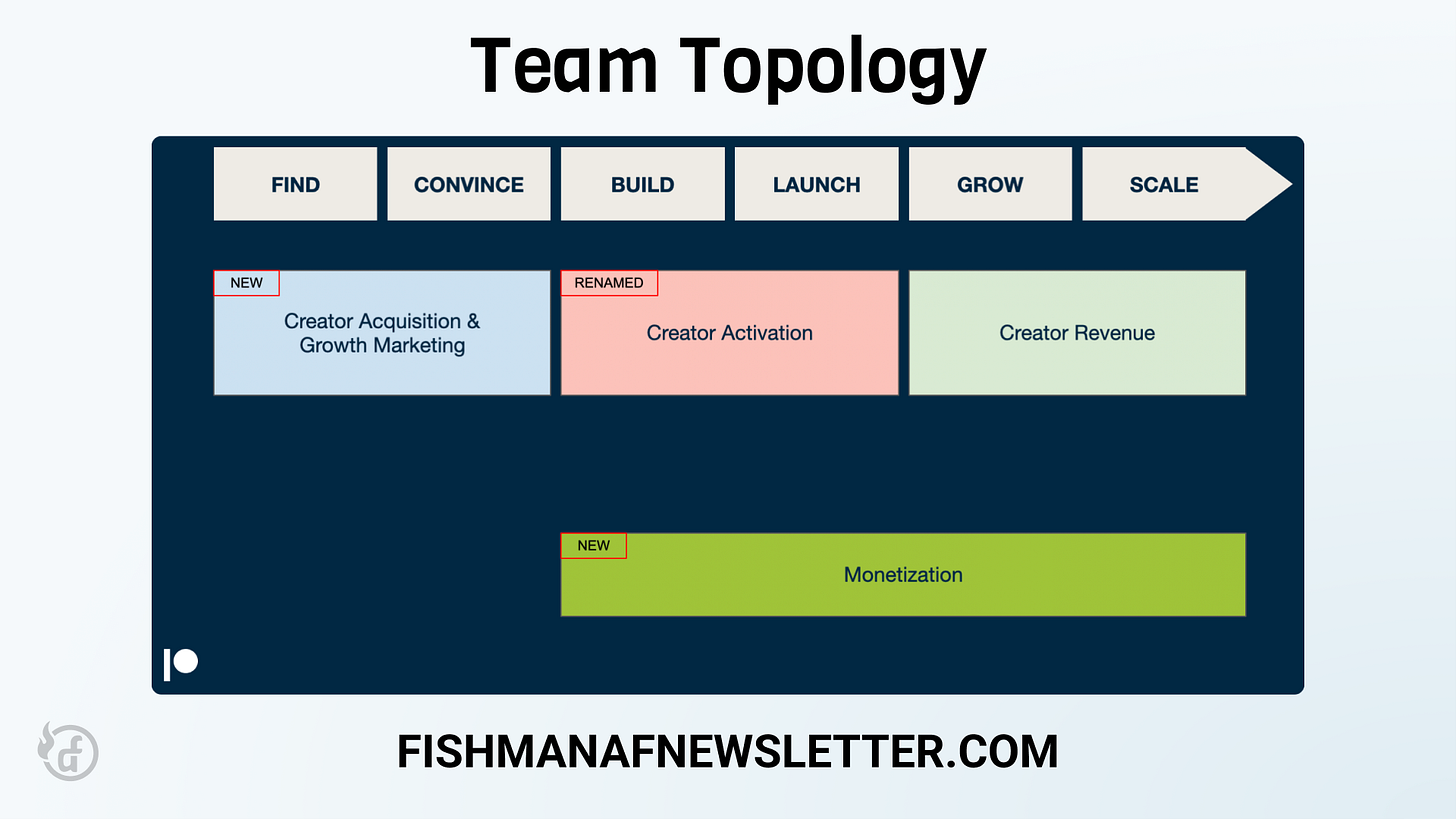









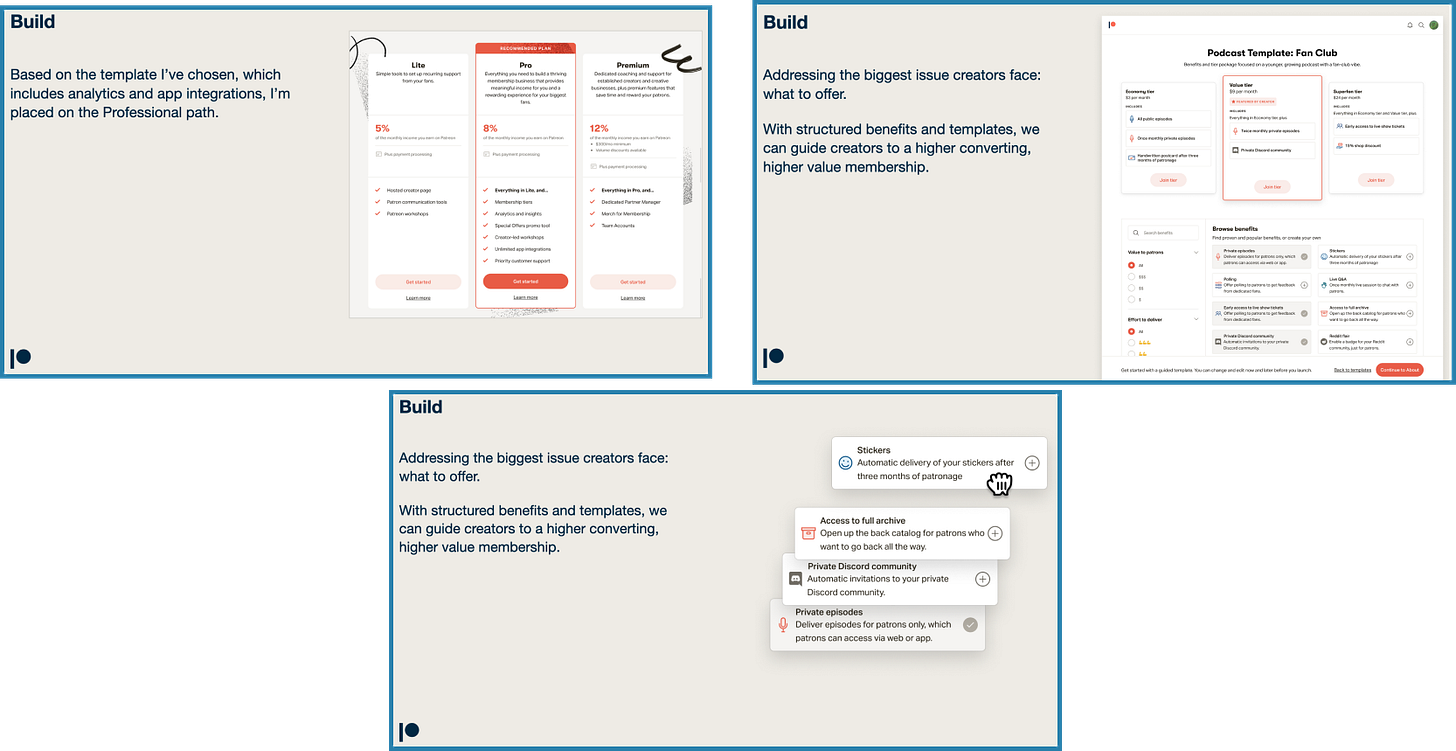
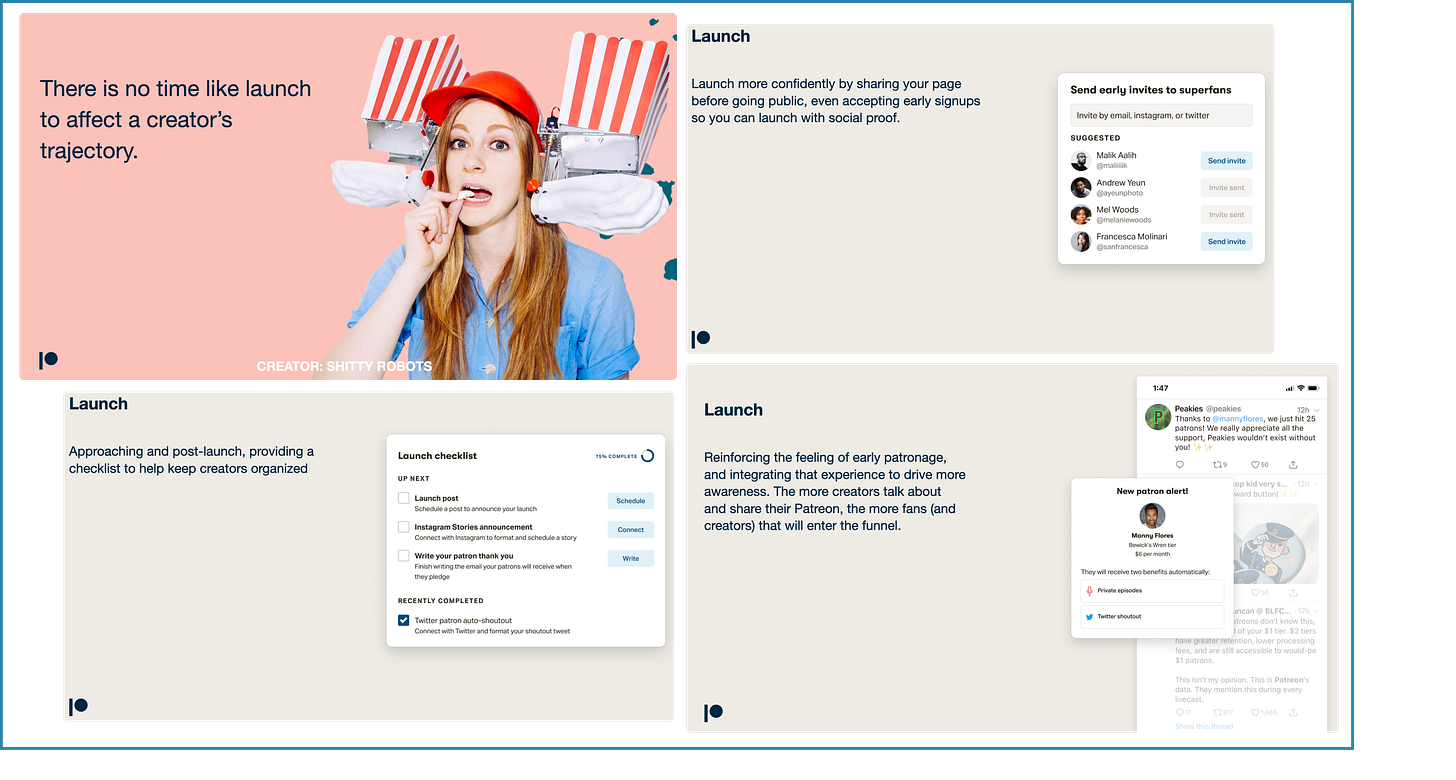




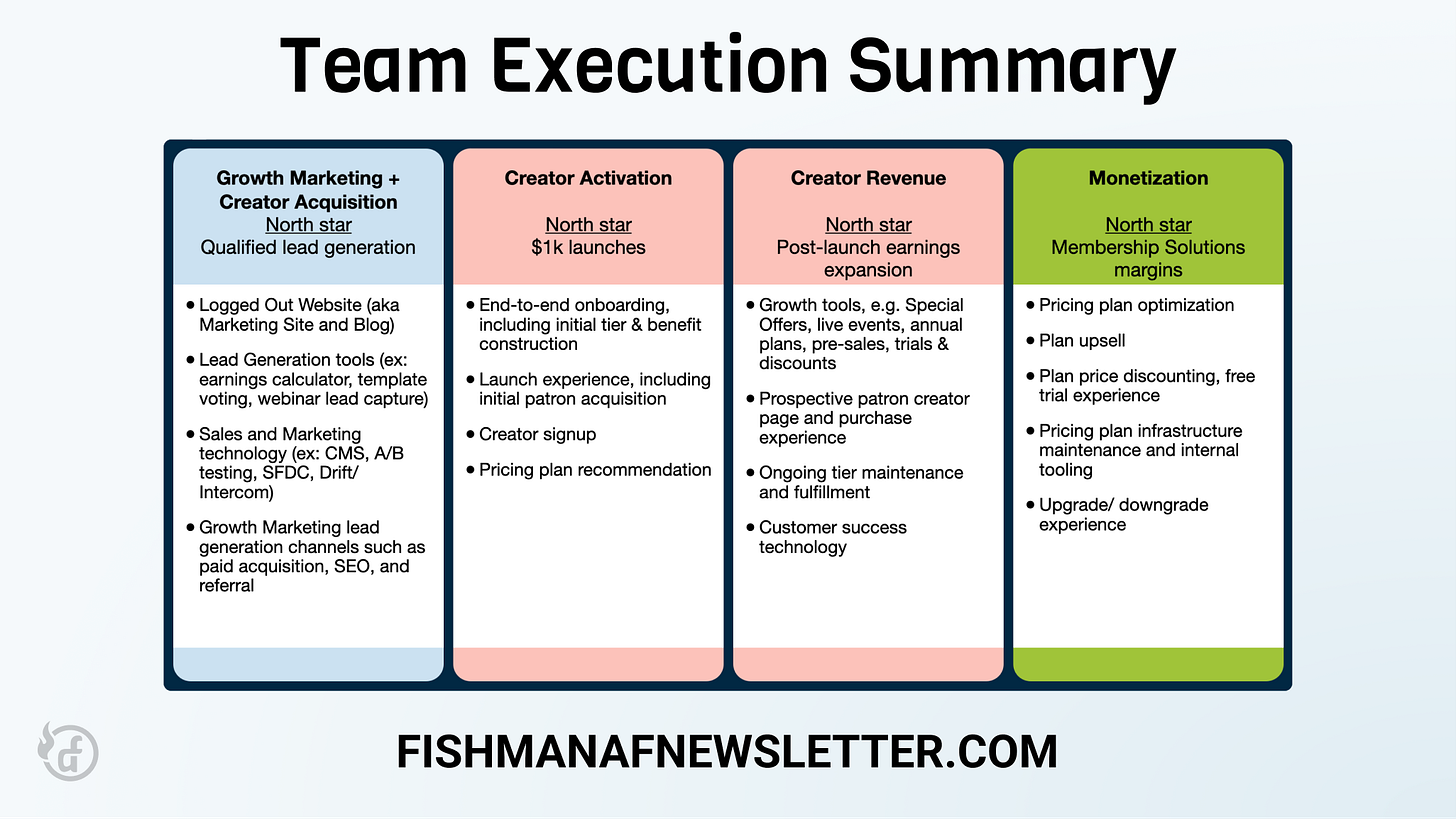


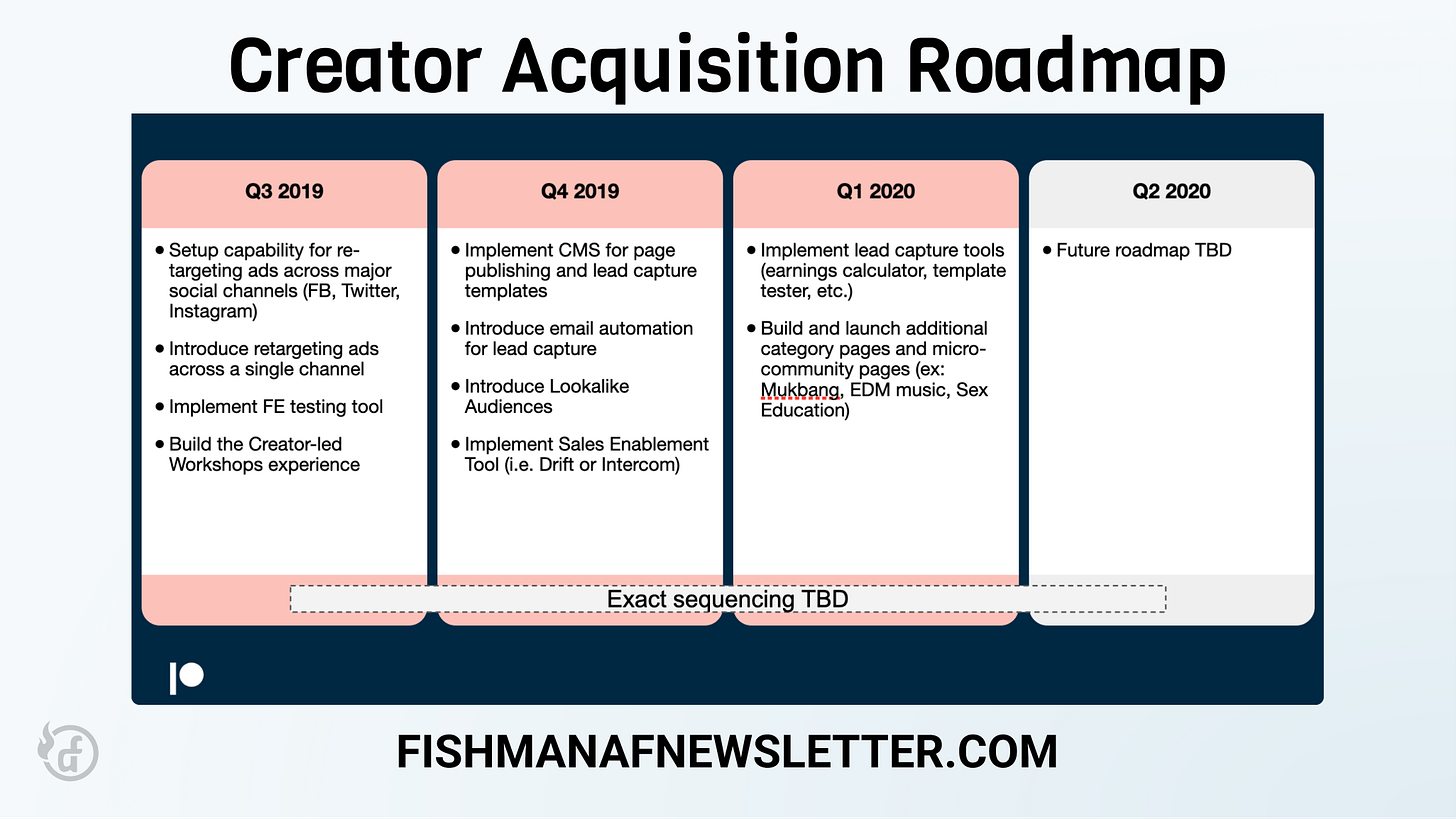



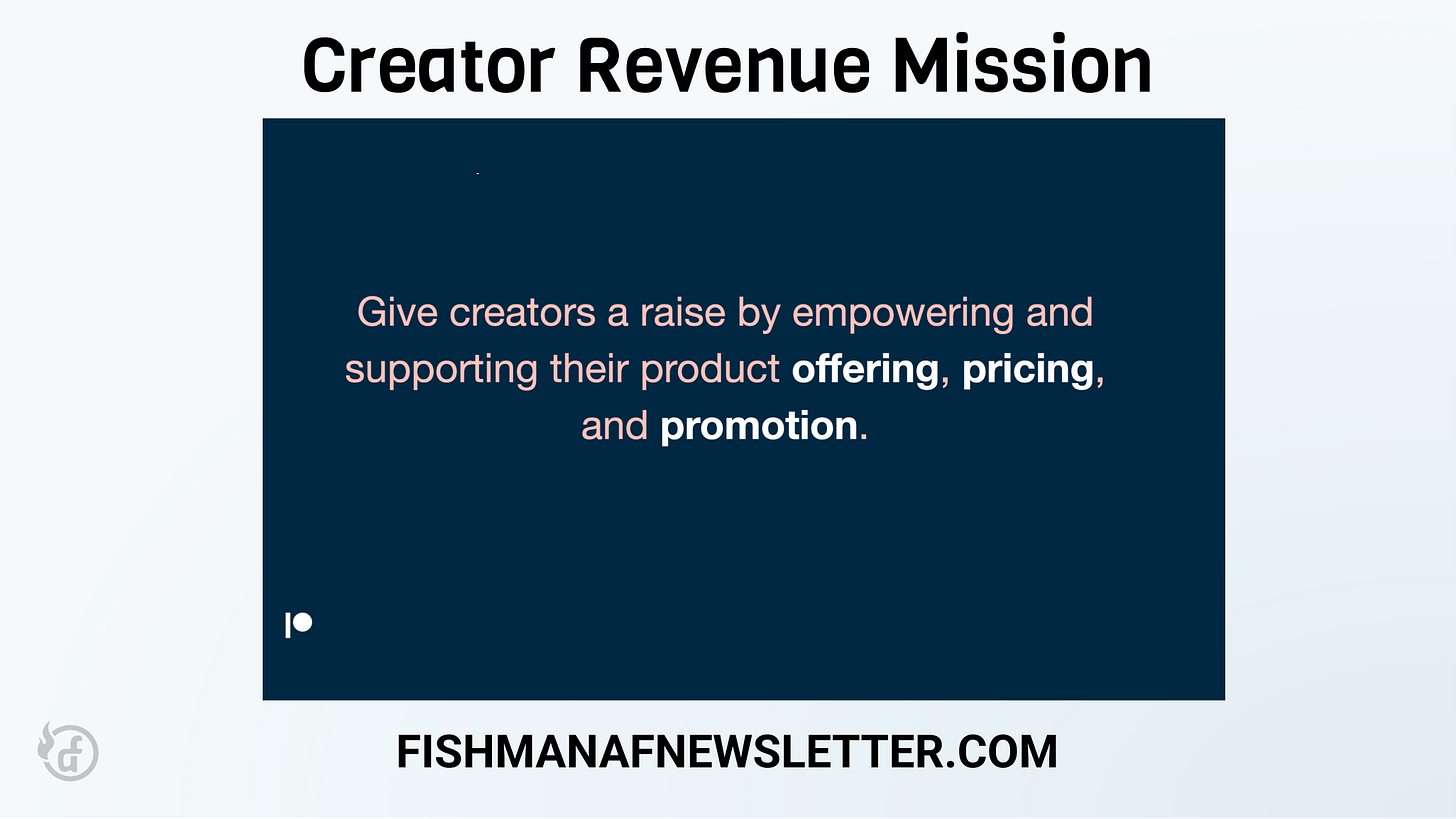




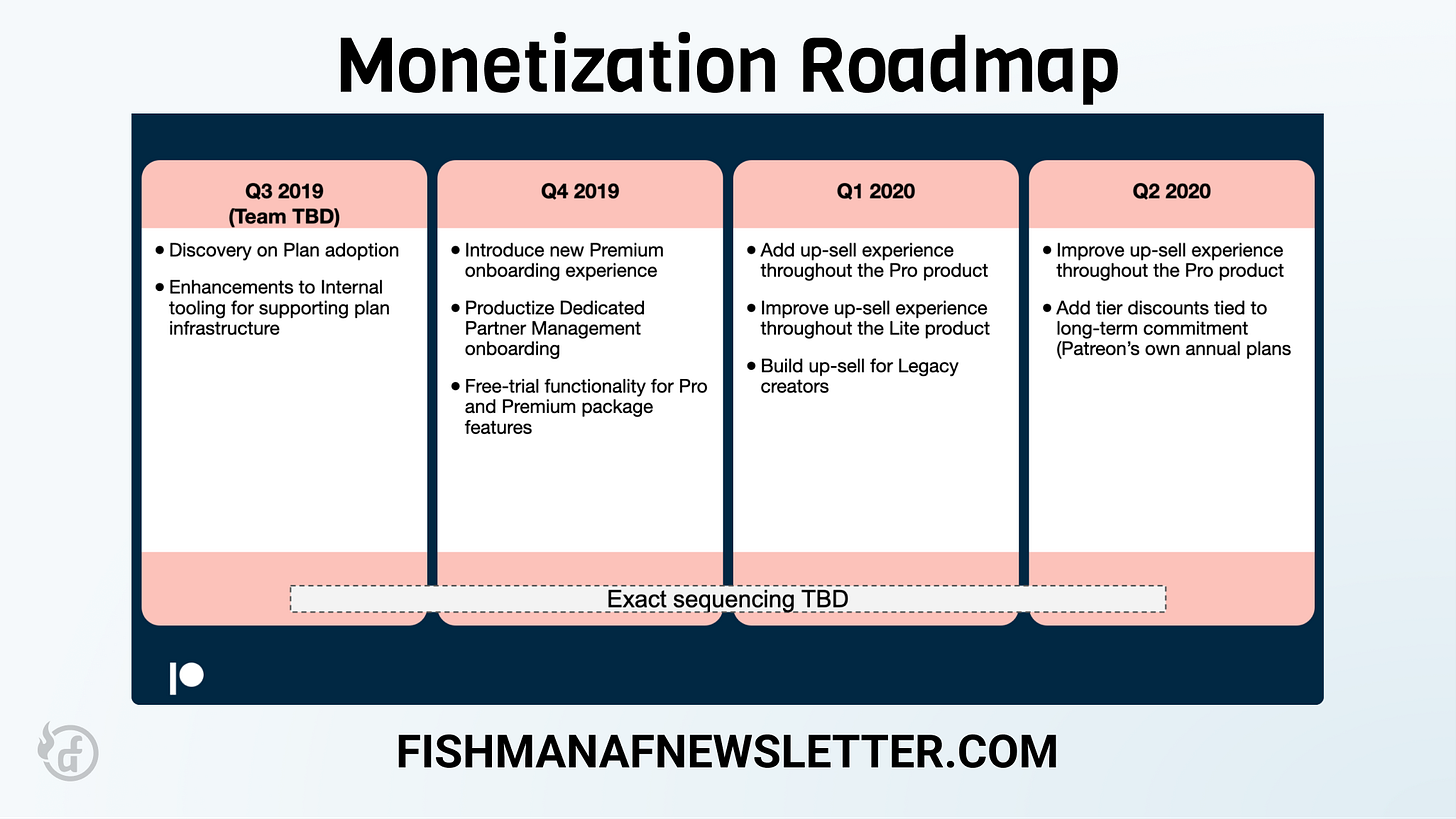

Mate, this is a great post! Building a growth strategy for any business is hard but Paetron has its unique challenges, but your framework effectively breaks these down. I’m curious, did you collaborate with any of your peers on this presentation? Who did you work with? 🙏
This is precious! Thank you so much!